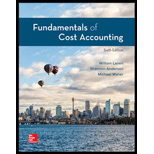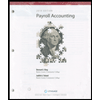
Concept explainers
Cost Allocation for Travel Reimbursement
Your company has a travel policy that reimburses employees for the “ordinary and necessary” costs of business travel. Employees often mix a business trip with pleasure by either extending the time at the destination or traveling from the business destination to a nearby resort or other personal destination. When this happens, an allocation must be made between the business and personal portions of the trip. However, the travel policy is unclear on the allocation method to follow.
Consider this example. An employee obtained a business-class ticket for $9,537 and traveled the following itinerary:

On the date of the flights between Chicago and Paris (and return), a restricted round-trip fare of $4,900 was available.
Required
- a. Compute the business portion of the airfare and state the basis for the indicated allocation that is appropriate according to each of the following independent scenarios:
- 1. Based on the maximum reimbursement for the employee.
- 2. Based on the minimum cost to the company.
- b. Write a short report to management explaining the method that you think should be used and why. You do not have to restrict your recommendation to either of the methods in requirement (a).
Want to see the full answer?
Check out a sample textbook solution
Chapter 12 Solutions
Loose-leaf For Fundamentals Of Cost Accounting
- Question 1. Pearl Leasing Company agrees to lease equipment to Martinez Corporation on January 1, 2025. The following information relates to the lease agreement. 1. The term of the lease is 7 years with no renewal option, and the machinery has an estimated economic life of 9 years. 2 The cost of the machinery is $541,000, and the fair value of the asset on January 1, 2025, is $760,000. 3. At the end of the lease term, the asset reverts to the lessor and has a guaranteed residual value of $45,000, Martinez estimates that the expected residual value at the end of the lease term will be $45,000. Martinez amortizes all of its leased equipment on a straight-line basis. 4. The lease agreement requires equal annual rental payments, beginning on January 1, 2025. 5. The collectibility of the lease payments is probable. 6. Pearl desires a 10% rate of return on its investments. Martinez's incremental borrowing rate is 11%, and the lessor's implicit rate is unknown. Annual rental payment is…arrow_forwardFinancial accountingarrow_forwardWhat the required return for the market? ? Solve question general Accountingarrow_forward
- Principles of Accounting Volume 2AccountingISBN:9781947172609Author:OpenStaxPublisher:OpenStax College
 Managerial AccountingAccountingISBN:9781337912020Author:Carl Warren, Ph.d. Cma William B. TaylerPublisher:South-Western College Pub
Managerial AccountingAccountingISBN:9781337912020Author:Carl Warren, Ph.d. Cma William B. TaylerPublisher:South-Western College Pub Financial And Managerial AccountingAccountingISBN:9781337902663Author:WARREN, Carl S.Publisher:Cengage Learning,
Financial And Managerial AccountingAccountingISBN:9781337902663Author:WARREN, Carl S.Publisher:Cengage Learning,  Managerial Accounting: The Cornerstone of Busines...AccountingISBN:9781337115773Author:Maryanne M. Mowen, Don R. Hansen, Dan L. HeitgerPublisher:Cengage Learning
Managerial Accounting: The Cornerstone of Busines...AccountingISBN:9781337115773Author:Maryanne M. Mowen, Don R. Hansen, Dan L. HeitgerPublisher:Cengage Learning





